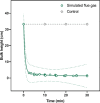Using Simulated Flue Gas to Rapidly Grow Nutritious Microalgae with Enhanced Settleability
- PMID: 33134689
- PMCID: PMC7594122
- DOI: 10.1021/acsomega.0c03492
Using Simulated Flue Gas to Rapidly Grow Nutritious Microalgae with Enhanced Settleability
Abstract
Favorable microalgal nutrition from waste resources and improved harvesting methods would offset costs for a process that could be scaled up to treat pollution and produce valuable animal feed in lieu of soy protein. Co-benefits include avoidance of carbon dioxide emissions, which may provide an additional revenue stream when carbon markets begin to flourish. To sustainably achieve these goals at scale, barriers to microalgal production such as tolerance for waste streams and dramatic improvement in dewatering and settleability of the microalgae must be overcome. Presently, it is largely assumed that nutritious microalgae, including Scenedesmus obliquus, would be inhibited by SO x and NO x in flue gases and settle slowly as discrete particles. Studies conducted with a 2 L photobioreactor, sparged with simulated coal-fired power plant flue gas, demonstrated that both biomass productivity and settling rates were increased. The average maximum biomass productivity was 700 ± 40 mg L-1 d-1, which significantly exceeded that of the control culture (510 ± 40 mg L-1 d-1). Thirty-minute trials of modeled bulk settling showed rapid coagulation, likely facilitated by extracellular polymeric substances, and compaction when the cultures were grown with simulated emissions. Control cultures, not exposed to the additional toxicants in flue gas, settled as discrete particles and did not show any settling progress within 30 min. Of the SO2 sparged into the cultivation system, (111 ± 4)% was captured as either SO4 2- in the medium or fixed in the S. obliquus biomass. The stress of simulated-emissions exposure decreased the S. obliquus protein contents and altered the amino acid profiles but did not decrease the fraction of methionine, a valuable amino acid in animal feed.
© 2020 American Chemical Society.
Conflict of interest statement
The authors declare no competing financial interest.
Figures









Similar articles
-
Sustainably Cultivating and Harvesting Microalgae through Sedimentation and Forward Osmosis Using Wastes.ACS Omega. 2021 Jun 25;6(27):17362-17371. doi: 10.1021/acsomega.1c01474. eCollection 2021 Jul 13. ACS Omega. 2021. PMID: 34278122 Free PMC article.
-
Application of a microalga, Scenedesmus obliquus PF3, for the biological removal of nitric oxide (NO) and carbon dioxide.Environ Pollut. 2019 Sep;252(Pt A):344-351. doi: 10.1016/j.envpol.2019.05.084. Epub 2019 May 17. Environ Pollut. 2019. PMID: 31158663
-
Biomitigation of CO2 from flue gas by Scenedesmus obtusiusculus AT-UAM using a hybrid photobioreactor coupled to a biomass recovery stage by electro-coagulation-flotation.Environ Sci Pollut Res Int. 2020 Aug;27(23):28561-28574. doi: 10.1007/s11356-020-08240-2. Epub 2020 Mar 4. Environ Sci Pollut Res Int. 2020. PMID: 32130637
-
Bio-fixation of flue gas from thermal power plants with algal biomass: Overview and research perspectives.J Environ Manage. 2019 Sep 1;245:519-539. doi: 10.1016/j.jenvman.2019.01.043. Epub 2019 Feb 23. J Environ Manage. 2019. PMID: 30803750 Review.
-
Current Techniques of Growing Algae Using Flue Gas from Exhaust Gas Industry: a Review.Appl Biochem Biotechnol. 2016 Mar;178(6):1220-38. doi: 10.1007/s12010-015-1940-4. Epub 2015 Dec 22. Appl Biochem Biotechnol. 2016. PMID: 26695777 Review.
Cited by
-
Sustainably Cultivating and Harvesting Microalgae through Sedimentation and Forward Osmosis Using Wastes.ACS Omega. 2021 Jun 25;6(27):17362-17371. doi: 10.1021/acsomega.1c01474. eCollection 2021 Jul 13. ACS Omega. 2021. PMID: 34278122 Free PMC article.
-
Intensive Microalgal Cultivation and Tertiary Phosphorus Recovery from Wastewaters via the EcoRecover Process.Environ Sci Technol. 2024 May 21;58(20):8803-8814. doi: 10.1021/acs.est.3c10264. Epub 2024 Apr 30. Environ Sci Technol. 2024. PMID: 38686747 Free PMC article.
References
-
- Robinson T. P.; Pozzi F.. Mapping supply and demand for animal-source foods to 2030. Animal Production and Health Working Paper: Rome, 2011; p 3.
-
- Searchinger T.; Waite R.; Hanson C.; Ranganathan J.. Creating a Sustainable Food Future: A Menu of Solutions to Feed Nearly 10 Billion People by 2050; World Resources Institute, 2018; pp 6–9.
LinkOut - more resources
Full Text Sources

